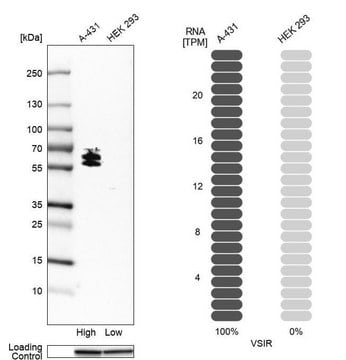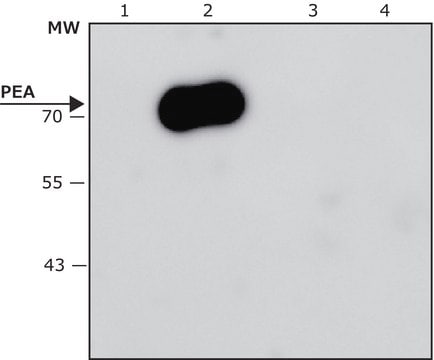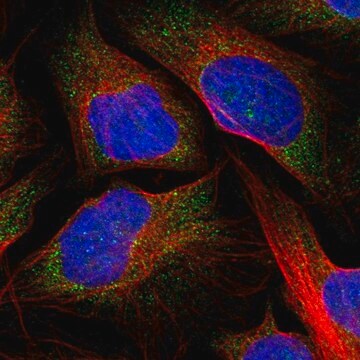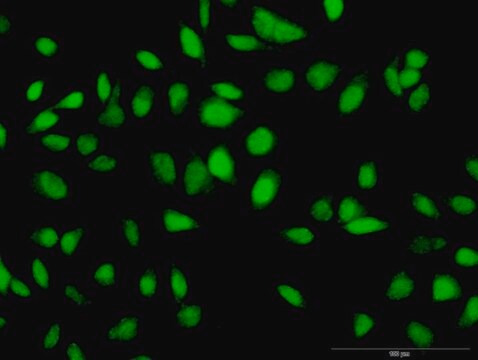推荐产品
生物源
rabbit
品質等級
共軛
unconjugated
抗體表格
affinity isolated antibody
抗體產品種類
primary antibodies
無性繁殖
polyclonal
產品線
Prestige Antibodies® Powered by Atlas Antibodies
形狀
buffered aqueous glycerol solution
物種活性
human
技術
immunofluorescence: 0.25-2 μg/mL
免疫原序列
SHQNVLSNYFPRVSFANQKAFRGVNGSPRISVTVGNIPKNSVSSSSQRRVSSSKISLRNSSKVTESASVMPSQDVSGSEDT
運輸包裝
wet ice
儲存溫度
−20°C
目標翻譯後修改
unmodified
基因資訊
human ... C1orf124(83932)
一般說明
C1orf124/Spartan, a protein that contains a PCNA-interacting peptide motif, called a PIP box, and a UBZ4 ubiquitin-binding domain, is involved in Rad18-mediated Proliferating Cell Nuclear Antigen (PCNA) ubiquitination and the regulation of DNA damage tolerance via post-replication repair (PRR). It promotes a feed-forward loop to enhance PCNA ubiquitylation and translesion DNA synthesis. Spartan plays an important role in preventing mutations associated with replication of damaged DNA.
Rabbit polyclonal Anti-C1orf124 antibody reacts with human zinc finger RAD18 domain-containing protein C1orf124/spartan.
免疫原
Zinc finger RAD18 domain-containing protein C1orf124 recombinant protein epitope signature tag (PrEST)
應用
Rabbit polyclonal Anti-C1orf124 antibody is used to tag zinc finger RAD18 domain-containing protein/Spartan for detection and quantitation by immunocytochemical and immunohistochemical (IHC) techniques such as ELISA, immunoblotting, and immunoprecipitation. It is used as a probe to determine the presence and roles of zinc finger RAD18 domain-containing protein/Spartan in the regulation of DNA damage tolerance via post-replication repair (PRR).
特點和優勢
Prestige Antibodies® are highly characterized and extensively validated antibodies with the added benefit of all available characterization data for each target being accessible via the Human Protein Atlas portal linked just below the product name at the top of this page. The uniqueness and low cross-reactivity of the Prestige Antibodies® to other proteins are due to a thorough selection of antigen regions, affinity purification, and stringent selection. Prestige antigen controls are available for every corresponding Prestige Antibody and can be found in the linkage section.
Every Prestige Antibody is tested in the following ways:
Every Prestige Antibody is tested in the following ways:
- IHC tissue array of 44 normal human tissues and 20 of the most common cancer type tissues.
- Protein array of 364 human recombinant protein fragments.
聯結
Corresponding Antigen APREST76479
外觀
Solution in phosphate-buffered saline, pH 7.2, containing 40% glycerol and 0.02% sodium azide
法律資訊
Prestige Antibodies is a registered trademark of Merck KGaA, Darmstadt, Germany
免責聲明
Unless otherwise stated in our catalog or other company documentation accompanying the product(s), our products are intended for research use only and are not to be used for any other purpose, which includes but is not limited to, unauthorized commercial uses, in vitro diagnostic uses, ex vivo or in vivo therapeutic uses or any type of consumption or application to humans or animals.
未找到合适的产品?
试试我们的产品选型工具.
儲存類別代碼
10 - Combustible liquids
水污染物質分類(WGK)
WGK 1
閃點(°F)
Not applicable
閃點(°C)
Not applicable
Kenji Takeda et al.
Cells, 12(24) (2023-12-22)
Advanced glycation end-products (AGEs), formed through glyceraldehyde (GA) as an intermediate in non-enzymatic reactions with intracellular proteins, are cytotoxic and have been implicated in the pathogenesis of various diseases. Despite their significance, the mechanisms underlying the degradation of GA-derived AGEs
Jaime Lopez-Mosqueda et al.
eLife, 5 (2016-11-18)
Ruijs-Aalfs syndrome is a segmental progeroid syndrome resulting from mutations in the SPRTN gene. Cells derived from patients with SPRTN mutations elicit genomic instability and people afflicted with this syndrome developed hepatocellular carcinoma. Here we describe the molecular mechanism by
我们的科学家团队拥有各种研究领域经验,包括生命科学、材料科学、化学合成、色谱、分析及许多其他领域.
联系客户支持








